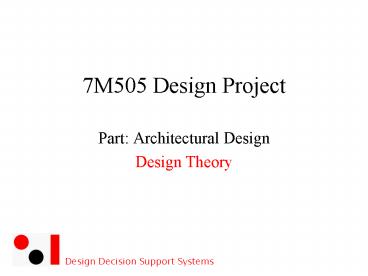7M505 Design Project - PowerPoint PPT Presentation
1 / 24
Title:
7M505 Design Project
Description:
7M505 Design Project Part: Architectural Design Design Theory Design project Learning goals: Acquiring insight in the nature of design, design problems, and design ... – PowerPoint PPT presentation
Number of Views:102
Avg rating:3.0/5.0
Title: 7M505 Design Project
1
7M505 Design Project
- Part Architectural Design
- Design Theory
2
Design project
- Learning goals
- Acquiring insight in the nature of design, design
problems, and design processes. - Hands-on experience with making a design.
- Structural reflection on the aspects of a design
process. - First overview of possibilities for Design
Decision Support (addressed later in the project).
3
Design project
- Learning goals
- Acquiring insight in the nature of design, design
problems, and design processes. - Hands-on experience with making a design.
- Structural reflection on the aspects of a design
process. - First overview of possibilities for Design
Decision Support (addressed later in the project).
Part one of the design project
4
Design project
- Learning goals
- Acquiring insight in the nature of design, design
problems, and design processes. - Hands-on experience with making a design.
- Structural reflection on the aspects of a design
process. - First overview of possibilities for Design
Decision Support (addressed later in the project).
Part two of the design project
5
Referred literature
- Roozenburg, N.F.M. and Eekels, J. (1994). Product
Design Fundamentals and Methods. Wiley,
Chichester.
key book DDSS Master programme
6
Items discussed previously
- Brief statement what is required by client.
- Analysis understanding the brief.
- Site characteristics of the location.
- Type information about the building type.
- Other sources inspiration and information.
- Representation how to depict the design.
- Evaluation understanding progress of design.
7
Theory Basic Design Cycle
- There are many different kinds of activities when
designing analysing, creating design, making
representations, evaluation, etc. - The order of these activities is not
pre-established. - Yet every design process has all these
activities! - This leads to the Basic Design Cycle
8
Theory Basic design cycle (BDC)
Function
Analysis
Criteria
Synthesis
Provisional design
Simulation
Expected properties
Evaluation
Value of the design
Approved design
9
Theory Basic design cycle (BDC)
Function
Analysis
Criteria
Synthesis
How does it work?
Provisional design
Simulation
Expected properties
Evaluation
Value of the design
Approved design
10
Products/documents in BDC
Function
Analysis
Criteria
Synthesis
Provisional design
Simulation
Expected properties
Evaluation
Value of the design
Approved design
11
Activities in BDC
Function
Analysis
Criteria
Synthesis
Provisional design
Simulation
Expected properties
Evaluation
Value of the design
Approved design
12
Elements of BDC
Function
General statement what needs to be designed
Analysis
Criteria
Synthesis
Provisional design
Simulation
Expected properties
Evaluation
Value of the design
Decision
Approved design
13
Elements of BDC
Function
Analysing the function that needs to be realized
Analysis
Criteria
Synthesis
Provisional design
Simulation
Expected properties
Evaluation
Value of the design
Decision
Approved design
14
Elements of BDC
Function
Analysis
From the analysis follow the criteria that the
design should meet
Criteria
Synthesis
Provisional design
Simulation
Expected properties
Evaluation
Value of the design
Decision
Approved design
15
Elements of BDC
Function
Analysis
Criteria
Creating ideas that solve the design problem
Synthesis
Provisional design
Simulation
Expected properties
Evaluation
Value of the design
Decision
Approved design
16
Elements of BDC
Function
Analysis
Criteria
Synthesis
Designs that are aimed to solve the design problem
Provisional design
Simulation
Expected properties
Evaluation
Value of the design
Decision
Approved design
17
Elements of BDC
Function
Analysis
Criteria
Synthesis
Provisional design
Simulating the expected behaviour of the design
understanding what the design means
Simulation
Expected properties
Evaluation
Value of the design
Decision
Approved design
18
Elements of BDC
Function
Analysis
Criteria
Synthesis
Provisional design
Simulation
From the simulation follow expectations what the
design actually achieves
Expected properties
Evaluation
Value of the design
Decision
Approved design
19
Elements of BDC
Function
Analysis
Criteria
Synthesis
Provisional design
Simulation
On the basis of the expected properties, the
design can be evaluated. This is explicitly based
on the criteria established before.
Expected properties
Evaluation
Value of the design
Decision
Approved design
20
Elements of BDC
Function
Analysis
Criteria
Synthesis
Provisional design
Simulation
Expected properties
From the evaluation follows an assessment of the
design, expressed as some kind of value
(numerical or more expressive as a feeling)
Evaluation
Value of the design
Decision
Approved design
21
Elements of BDC
Function
Analysis
Criteria
Synthesis
Provisional design
Simulation
Expected properties
Based on the evaluation and value of the design,
the designer decides whether to continue
designing, or if the design is finished
Evaluation
Value of the design
Decision
Approved design
22
Theory Basic Design Cycle
- The BDC does not strictly prescribe the order of
activities! - The BDC distinguishes the various activities and
documents in the design process. - The BDC identifies the general relations between
the activities and documents. - But any of these activities must have been at
least once in a design process.
23
What to do?
- Analyse your complete design process in terms of
BDC - Use your time-stamped drawings and texts as a
basis. - Describe per drawing/text what kind of document
it is (function, criteria, provisional design,
expected properties, value of the design, or
approved design) and from which activity it is
the result (analysis, synthesis, simulation,
evaluation, or decision).
24
Tips n Tricks
- Do not remake your design just because you are
now analysing it. Use whatever you have now. - There is no described format for each of the
documents or activities it can be a word,
thought, or a large drawing or lengthy document. - Work through your process in the same order as
you designed the house.































